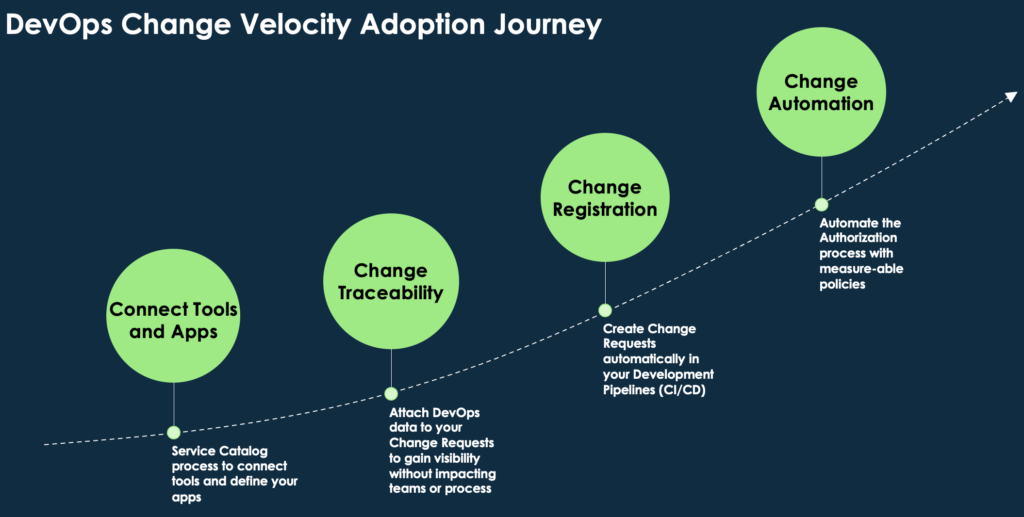DevOps & Change Velocity
DevOps & Change Velocity are part of ServiceNow. and offer different suites of functionality. In the dynamic landscape of software development, choosing the right tools and methodologies can make all the difference.
Definition of Change Velocity
Change Velocity signifies the speed at which alterations are incorporated into a software development or IT environment. This encompasses the efficiency in integrating updates or enhancements into existing systems, applications, or processes.
Within IT Service Management (ITSM), Change Velocity emerges as a pivotal metric for assessing the efficacy of change management procedures. It quantifies the frequency and pace at which changes undergo proposal, review, approval, and deployment, all while maintaining the stability and reliability of the IT infrastructure.

A higher Change Velocity indicates a more nimble and responsive change management system, capable of adeptly adapting to evolving business demands and technological advancements. Conversely, a lower Change Velocity may signal a slower and potentially more unwieldy change management process.
In essence, vigilantly monitoring and optimizing Change Velocity stands as a vital endeavor in ensuring an organization’s IT environment retains its adaptability, security, and alignment with strategic objectives.
Overview of ServiceNow DevOps Change Velocity
In today’s FAQs, we turn our attention to ServiceNow, a widely recognized leader in digital workflow platforms. ServiceNow Agile DevOps and Change Velocity have been meticulously crafted to address specific facets of the development process. This equips organizations with the precise tools they need to not only streamline operations but also to significantly enhance productivity.
This article will delve deep into the intricacies of these platforms. It will conduct a comprehensive comparative analysis with the tried-and-true Software Development Life Cycle (SDLC) framework. This approach aims to empower businesses, ensuring they are well-equipped to make astute decisions regarding their development ventures. What do these two packages entail, and how do they actively contribute to supporting the Software Development Life Cycle?
Below, you will find a comprehensive table that offers a high-level comparison of the functions inherent in the Software Delivery Life Cycle, ITSM Pro Change Velocity, and DevOps Agile:
| Function | Software Development Life Cycle | ITSM Pro Change Velocity | DevOps Agile 2.0 |
|---|---|---|---|
| Planning | Define project scope and goals | Create change requests | Plan and prioritize |
| Design | Develop technical specifications | N/A | Design and develop |
| Development | Write code | N/A | Develop and test |
| Testing | Test software | N/A | Test and deploy |
| Deployment | Deploy software | Approve change requests | Deploy and monitor |
| Maintenance | Maintain software | N/A | Maintain and improve |
Streamlined Change Request Handling
One of its key features lies in the automatic creation of change requests for development teams. This functionality ensures that developers can remain steadfastly focused on their coding tasks without being burdened by administrative overhead.
Automation for Approval Process
Change Velocity adeptly leverages automation to accelerate the change approval process. By automating most approvals, it significantly minimizes the potential for failures and guarantees smoother transitions.
Complex ITIL Change Management
In addition to its core functionalities, ITSM Pro Change Velocity is specifically tailored to adeptly handle even the most complex ITIL changes. This capability empowers change managers in overseeing intricate processes with exceptional efficiency.
Unpacking DevOps Agile
DevOps Agile emerges as a potent solution meticulously honed for managing agile development processes within organizations.
Seamless Integration of Development Tools
One of the standout features of DevOps Agile is its innate ability to seamlessly connect development tools with change management systems. This integration not only facilitates automatic ticketing but also expedites approval processes, thus streamlining workflows.
Reliable Data for Change Management
Without a doubt, DevOps Agile ensures reliability and compliance by providing change managers and operators with a steady flow of dependable data. This information is not only automatically populated but also intricately interconnected, thus substantially reducing the likelihood of discrepancies.
DevOps & Change Velocity with SDLC
ServiceNow Agile DevOps and ServiceNow Change Velocity have distinct roles in the software development process, both aiming to enhance efficiency through unique methods.
Agile DevOps seamlessly integrates development with change management, automating ticketing and approval processes. This accelerates the development cycle and ensures compliance with organizational policies.
Change Velocity, on the other hand, streamlines change requests, automating their creation and approval. It excels in handling complex ITIL changes, reducing human error and expediting implementations.
Both platforms improve development efficiency and reliability. Agile DevOps empowers developers by integrating their tools, while Change Velocity streamlines change requests.
Together, ServiceNow Agile DevOps and Change Velocity automate, streamline, and align the development process, leading to a comprehensive approach to software development and change management.
ServiceNow Agile DevOps
The components that constitute ServiceNow Agile DevOps are its precision engineering tailored for agile development process management. Its inherent strengths encompass the seamless integration it provides and the reliable data it furnishes.
ServiceNow Change Velocity

On the flip side, ServiceNow Change Velocity is expertly optimized for managing change requests. Its primary advantages lie in its ability to streamline the handling of change requests and seamlessly automate approval processes.
Conclusion DevOps & Change Velocity
In summary, it is crucial for organizations aiming to optimize their software development processes to grasp the nuanced distinctions between SDLC, ServiceNow Agile DevOps, and ServiceNow Change Velocity.
While SDLC provides a comprehensive framework, ServiceNow Agile DevOps and ServiceNow Change Velocity offer specialized tools that target specific facets of the development lifecycle. By leveraging these solutions, organizations can achieve not only heightened efficiency but also unwavering reliability in their software delivery endeavors.
Other Resources for DevOps & Change Velocity
- 30 Best DevOps Tools for 2023: Git, Docker, Jenkins and More | Simplilearn
- Basics of Agile Development (servicenow.com)
- Agile Development – Create a product
- Agile Sprint Dashboard
- Get started with Azure DevOps learning path – Training
- Get started with GitHub documentation – GitHub Docs
- Get started with GitLab | GitLab
- How To Get Started With Jenkins. A Beginner’s Guide with an example
- Introduction To Software Development LifeCycle | Simplilearn
- ITSM Capability Model- L1
- ITIL Problem Management: The Essential Guide – Ivanti
- Writing effective stories in Agile Development 2.0 (servicenow.com)
-
Getting Started
- AI: ServiceNow Virtual-Agent Chatbot
- BMC Remedy ITSM Reference
- Burp Suite Professional & Web Security Process
- COE for Human Resources
- Conduct A Windows-Security Scan
- Employee Journey Management ServiceNow
- Getting Started: Engagement Manager
- Introduction to Knowledge Management
- Knowledge Categorization "Find-ability"
- One-IT: Effective Ticket Handling
- Productivity Tips for Knowledge-Users
- Productivity: Service Operations Workspace
- Quick Start Guide
- Service Catalog Order Guides
- Your Next Steps
-
- Advanced Program Management
- AI: ServiceNow Virtual-Agent Chatbot
- Artificial Intelligence A-Z Glossary
- Business Process Optimization Reviews
- Category Hierarchy and Tabs Layout
- Employee Journey Management ServiceNow
- GE Change Acceleration Process
- GRC Managed Risk
- Overview: Employee Center Pro
- Productivity: Service Operations Workspace
- Proper Ticket Handling Imperative
- Public Sector Digital Services
- RIDAC: Strategic Portfolio Management
- SOX Control-Management and Attestation
-
- Articles coming soon
-
FAQs
- Best of ServiceNow Vancouver
- Chat GPT FAQS
- DevOps & Change Velocity
- Enhancing End-User Service Experience
- FAQs: Governance Risk Compliance
- How-To Import ServiceNow Stories 🚀
- Knowledge Categorization "Find-ability"
- Role of CMDB-Management Service-Owner
- Service Catalog Process FAQs
- ServiceNow IRM SOX FAQs
- Strategic Portfolio Management FAQs
- Ticket Handling Infographic FAQs
- Understanding Clop Ransomware Mitigation
- Vulnerability Response Workspace Module
- Washington ESC or Knowledge Portal?
-
- AI & GRC Defense Against Security-Data Breach
- AI and Improved Knowledgebase-Search
- AI Revolutionizes Service Management
- AutomatePro AutoTest Custom-Testing
- AutomatePro AutoTest: Getting Started
- Best of ServiceNow Vancouver
- CMDB Health Dashboard
- Comparing ServiceNow-Strategic-PM to Microsoft-PM
- Demystifying Taxonomy Categorization
- DevOps & Change Velocity
- Efficient Workday to ServiceNow Integration
- Email-to-Incident is Costly Inefficiency
- Enhancing End-User Service Experience
- Financial Services Operations
- Gamifying ITSM Excellence
- GRC Industry Reference Matrix
- Introducing Security Incident Response
- Role of CMDB-Management Service-Owner
- Service Catalog Process FAQs
- ServiceNow Executive Reporting Approaches
- ServiceNow Virtual Agent Chatbot
- SPM Gantt Chart Presentation
- Strategic Portfolio Management FAQs
- Vulnerability Response Test Plan
- Vulnerability Response Workspace Module
- Washington ESC or Knowledge Portal?
- Show Remaining Articles11 Collapse Articles
-
Glossary Reference
-
Blog
- 2021: VP Harris Inauguration Elevates Diversity and Executive Leadership
- 5-Star ITSM Solutions
- 5-Step Policy-Compliance Risk Management
- AI & GRC Defense Against Security-Data Breach
- AI Revolutionizes Service Management
- AI: Knowledge Centered Support
- ChatGPT Ethics and FTC
- CMDB Corporate Governance for Publicly Held Companies
- Community Crisis Resource Reference List
- Covid Cyber Employment Fraud: $Millions in Job Fraud, $Billions in Unemployment Fraud. Recruiters and Jobseekers Paradigm shift
- Does Post Covid Demand, "Evolve or Fold" Data Strategy?
- Financial Services Operations
- Freshwork's Multichannel vision for FreshService (ITSM)
- Gamifying ITSM Excellence
- GRC Industry Reference Matrix
- Imperative: Governance Risk Compliance
- Jobs n Career Success: Employment News
- Microsoft Teams Tripping Transcription Tenancy.
- Predictive Intelligent Situational Awareness
- Remedy to ServiceNow Migration
- Review and Approve Knowledge
- ROI: Demand AI Service Management
- Top Trends in Project Management
- Uber's Call Center Security Social Engineering Massive System Breach
- Vulnerability Remediation RACI
- Walk Up Experience- Design-To-Deliver
- World Talent Economy Forum on Global Competitiveness
- Show Remaining Articles12 Collapse Articles
-
Healthcare
-
Workday
-
Network Connectivity Solutions
-
Business Process Methodologies

